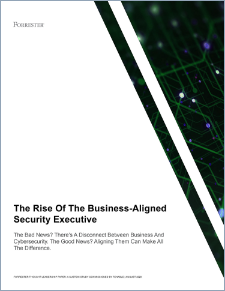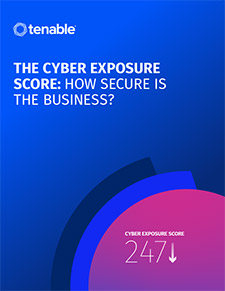
The bad news? There's a disconnect between business and cybersecurity. The good news? Aligning them can make all the difference.
If you've served as a CISO, CSO or other cybersecurity leader for any length of time, you've likely had a CEO, board member or other senior executive ask you “how secure are we?” on a fairly frequent basis. And you also know answering that question is not as easy as it might seem.
At a time when enterprise risks are rapidly shifting — enter pandemics, economic downturns and remote work — the cyberattacks and threats thriving around the globe not only amplify each risk, they have elevated cybersecurity to a topic of board-level scrutiny. Yet, those of us on the frontlines grapple with a host of challenges making it difficult to provide our business leaders with a clear picture of our organization's cybersecurity posture.
With an eye toward surfacing some of these key challenges and helping security leaders initiate a meaningful dialog with their business counterparts, Tenable commissioned Forrester Consulting to conduct an online survey of 416 security and 425 business executives and a study from the findings to examine cybersecurity strategies and practices at midsize to large enterprises. The resulting study, The Rise of the Business-Aligned Security Executive, reveals a disconnect between the expectations of the business and the realities facing security leaders. But it also reveals perhaps the single-biggest opportunity facing digital enterprises today — elevating the role of the CISO to equal stature as other executive roles.
The future belongs to the business-aligned cybersecurity leader
The study reveals four key themes:
- Cybersecurity threats thrive amidst a climate of uncertainty, making it a topic worthy of board-level visibility. The vast majority of organizations (94%) have experienced a business-impacting* cyberattack or compromise within the past 12 months. Roughly two-thirds (65%) said these attacks involved operational technology (OT) assets.
- Business leaders want a clear picture of their organizations' cybersecurity posture, but their security counterparts struggle to provide one. Just four out of 10 security leaders say they can answer the question, “How secure, or at risk, are we?” with a high level of confidence. A lack of consolidated data and associated business context contributes to the challenges facing cybersecurity decision-makers.
- There is a disconnect in how businesses understand and manage cyber risk. Fewer than 50% of security leaders are framing the impact of cybersecurity threats within the context of a specific business risk. Only half of security leaders (51%) say their security organization works with business stakeholders to align cost, performance, and risk reduction objectives with business needs. Only four in 10 security leaders (43%) report they regularly review the security organization's performance metrics with business stakeholders.
- Cybersecurity needs to evolve as a business strategy. This can't happen until security leaders have better visibility into their attack surface. Just over half of security leaders report that their security organization has a holistic understanding and assessment of the organization's entire attack surface and fewer than 50% of security organizations are using contextual threat metrics to measure their organizations' cyber risk. This means their ability to analyze cyber risks and prioritize and execute remediation based on business criticality and threat context is limited.
The study shows that when security and business leaders are aligned around agreed-upon business risk data, they deliver significant, demonstrable results. The business-aligned security leader is eight times as likely as their more siloed peers to be highly confident in their ability to report on their organizations' level of security or risk. Even more notable in today's economic climate, with a global economic downturn causing organizations to re-evaluate their spending: 85% of business-aligned security leaders have metrics to track cybersecurity ROI and impact on business performance versus just 25% of their more reactive and siloed peers.
As Dan Bowden, the CISO of Sentara Healthcare, noted in an interview with Tenable last year: “In the climate today, there's so much focus from society about companies doing better managing risk, every leadership team and every board in every organization wants to be part of the story of fixing the problem. If you can give them good data about exposure, which things do we really need to do, they understand the data, they can relate to the data. They want to be part of the story to help you solve the problem and manage risk better.”
“In the climate today, there's so much focus from society about companies doing better managing risk, every leadership team and every board in every organization wants to be part of the story of fixing the problem.” - Dan Bowden, CISO, Sentara Healthcare
In order to achieve alignment, CISOs and other security and risk management leaders need the right combination of technology, data, processes and people. For example, the vast majority of business-aligned organizations (80%) have a Business Information Security Officer (BISO) or similar title, compared with only 35% of their less-aligned counterparts. The study also reveals that business-aligned security leaders outpace their more reactive and siloed counterparts in automating key vulnerability assessment processes by margins of +49 to +66 percentage points.
In the following chapters, we explore these and other findings from the study and provide guidance on how Tenable can help your organization address the technology and data challenges behind this disconnect. In Chapter 1, we take a deeper dive into the many challenges security leaders face in answering the question, “How secure are we?” Chapter 2 takes a “ripped from the headlines” view of how organizations responded to COVID-19 to articulate how the business-cyber disconnect manifests in real life. In Chapter 3, we discuss how existing cybersecurity metrics fall short in giving CISOs and other security leaders the data they need to address business risk. And Chapter 4 and Chapter 5 discuss what a business-aligned cybersecurity practice looks like — and how you can get started building one in your organization — along with our tips and recommendations for transforming your own role into that of a business-aligned cybersecurity leader.
—Robert Huber, Chief Security Officer, Tenable *For the purpose of this study, “business-impacting” relates to a cyberattack or compromise that resulted in one or more of the following: a loss of customer, employee or other confidential data; interruption of day-to-day operations; ransomware payout; financial loss or theft; and/or theft of intellectual property.How organizations can objectively measure cyber risk
By adopting best practices of Cyber Exposure management, organizations can more effectively reduce functional silos and introduce a common language for discussing risk — one that is understood by both the business and security teams. With Tenable, organizations are able to holistically assess, manage and ultimately reduce their cyber risk across the modern attack surface. Cyber Exposure provides the means for organizations to objectively measure their cyber risk — both internally and against industry peers — in order to help guide strategic decision-making and better align security initiatives with business objectives. Just as other functions have a system of record — such as information technology service management (ITSM) for IT and customer relationship management (CRM) for sales — Tenable can serve as a system of record to effectively manage and measure cyber risk as a business risk.










